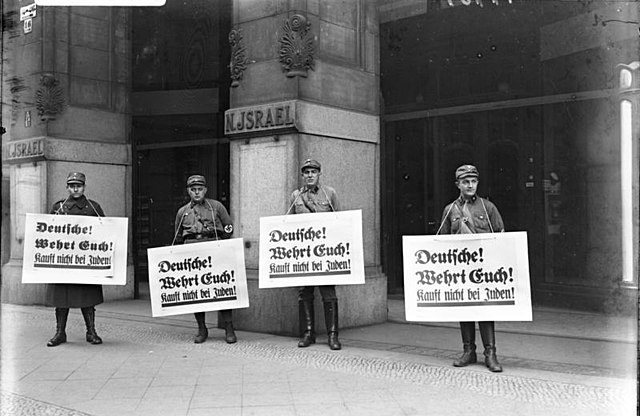Nazi boycott of Jewish businesses
The Nazi boycott of Jewish businesses in Germany began on April 1, 1933, and was claimed to be a defensive reaction to the anti-Nazi boycott, which had been initiated in March 1933. It was largely unsuccessful, as the German population continued to use Jewish businesses, but revealed the intent of the Nazis to undermine the viability of Jews in Germany.
Nazi SA paramilitaries outside Israel's Department Store in Berlin. The signs read: "Germans! Defend yourselves! Don't buy from Jews."
SA paramilitaries outside a Berlin store posting signs with: "Deutsche! Wehrt Euch! Kauft nicht bei Juden!" ("Germans! Defend yourselves! Don't buy from Jews!").
Nameplate of Dr. Werner Liebenthal, notary and advocate. The plate was hung outside his office on Martin Luther Str, Schöneberg, Berlin. In 1933, following the Law for the Restoration of the Professional Civil Service the plate was painted black by the Nazis, who boycotted Jewish-owned offices.
Members of the SA boycotting Jews, April 1, 1933
The anti-Nazi boycott was an international boycott of German products in response to violence and harassment by members of Adolf Hitler's Nazi Party against Jews following his appointment as Chancellor of Germany on January 30, 1933. Examples of Nazi violence and harassment included placing and throwing stink bombs, picketing, shopper intimidation, humiliation and assaults. The boycott was spearheaded by some Jewish organizations but opposed by others.
A matchbook cover issued by the Non-Sectarian Anti-Nazi League to advertise the boycott
A news photograph of the "Boycott Nazi Germany" rally held in Madison Square Garden on March 15, 1937
SA paramilitaries in Berlin on April 1, 1933, with boycott signs, blocking the entrance to a Jewish-owned shop. The signs read "Germans! Defend yourselves! Don't buy from Jews!", while another sign in the background says "Germans defend yourselves against Jewish atrocity propaganda! Buy only in German shops!".







